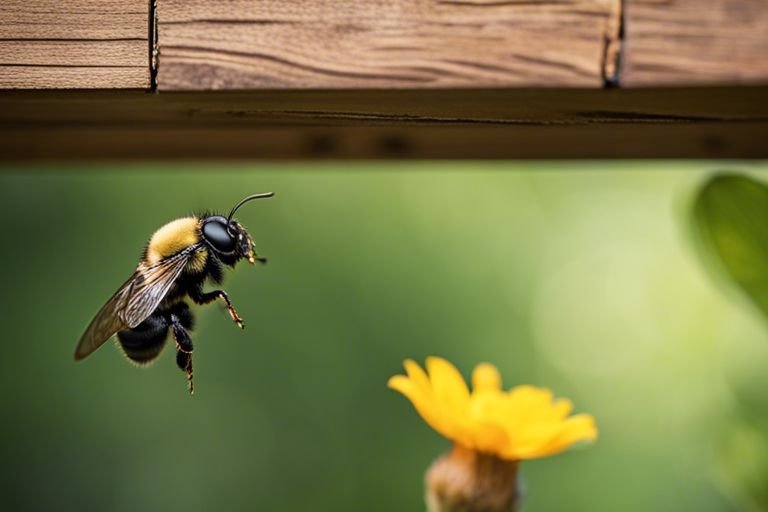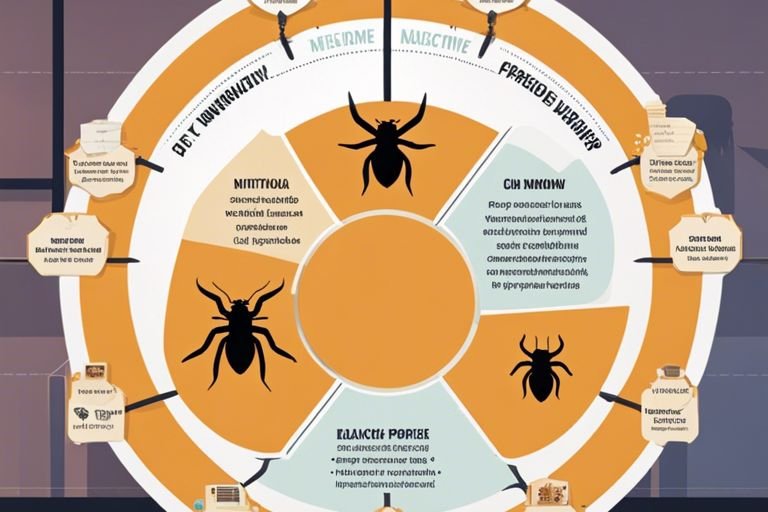As an entomologist, I often get asked about carpenter bees and whether or not they have stingers. The answer is yes, carpenter bees do have stingers. Unlike honeybees, carpenter bees are solitary insects and the females are the ones equipped with a stinger. These wood-boring insects can be seen buzzing around wooden structures, searching for a place to drill and lay their eggs. If you have a wooden deck, porch, or even furniture, it’s important to be aware of these insects and their potential to cause damage. In this post, I will share more about carpenter bees, including their behavior, potential threats, and ways to deal with them if they become a problem. So, if you’ve ever wondered about these fascinating wood-boring insects, keep on reading to learn more!
Key Takeaways:
- Carpenter Bees do have stingers which they use for self-defense
- Female Carpenter Bees are the ones with stingers as they need the ability to defend their nests
- Male Carpenter Bees do not have stingers and are unable to sting
- Carpenter Bees are not aggressive, but may sting if they feel threatened
- Understanding Carpenter Bee behavior and habits can help prevent encounters and potential stings
Understanding Carpenter Bees
A fascinating insect to observe, carpenter bees are known for their unique wood-boring abilities. Understanding their physical characteristics and behavior patterns can help you better manage and coexist with these intriguing creatures.
Physical characteristics
Carpenter bees are large, robust insects, with females measuring up to an inch in length. They are typically black with a metallic sheen, and may have pale yellow or white markings on their bodies. One of the most distinctive physical features of carpenter bees is their smooth, hairless abdomens. Additionally, their wings produce a distinctive buzzing sound when in flight, making them easily identifiable.
Behavior patterns
One of the most fascinating aspects of carpenter bees is their wood-boring behavior. They create tunnels in wooden structures as nesting sites, which can lead to structural damage over time. Unlike other bee species, carpenter bees are solitary insects, with each female creating her own individual nest. It’s important to note that while male carpenter bees may be territorial and aggressive in defense of their nests, they do not have stingers and are incapable of inflicting harm. However, the females do possess stingers, but they are not aggressive and will only sting if directly handled or provoked.
Do Carpenter Bees Have Stingers?
Assuming you are delving into the world of carpenter bees, you may be wondering if these wood-boring insects have stingers. The short answer is yes, they do. Carpenter bees, like many other species of bees, are equipped with stingers as a means of protection against potential threats, including predators and humans.
Anatomy of a Carpenter Bee Stinger
The carpenter bee’s stinger is a modified ovipositor, which is the organ typically used for laying eggs. This means that only female carpenter bees have stingers, as males do not possess an ovipositor. The stinger itself is connected to a venom sac, which contains the venom that the bee can inject into a potential threat. The stinger is designed to penetrate the exoskeleton of insects or the skin of larger creatures, delivering a painful sting that can dissuade predators or intruders.
Defensive Uses of the Stinger
When it comes to defensive uses, carpenter bees will use their stingers when they feel threatened or believe their nest is in danger. If you inadvertently disturb a carpenter bee nest, such as by agitating the bees or attempting to demolish their wooden tunnels, you may find yourself on the receiving end of a sting. It’s important to note that while female carpenter bees do possess stingers, they are not inherently aggressive and will typically only use them as a last resort when feeling threatened. However, when stung, the venom can cause pain and discomfort, especially for those who may have an allergy to bee stings.
Learning About Wood-Boring Insects
After encountering carpenter bees in my own garden and wooden structures, I became fascinated by these wood-boring insects. As I delved into research, I learned that carpenter bees are a type of wood-boring insect that can cause significant damage to wooden structures. It’s essential to understand these insects and their behaviors in order to prevent and control the potential damage they may inflict.
Impact on wooden structures
These bees are named “carpenter” bees for a reason. They bore into wood to build their nests, creating tunnels and galleries where they lay their eggs. Although only the female carpenter bee has a stinger, the males are aggressive and will act defensively if they feel threatened. The damage caused by carpenter bees can weaken the structure of wooden porches, decks, eaves, and other wooden structures. Over time, this can lead to structural integrity issues and costly repairs.
Methods for prevention and control
There are several methods for preventing and controlling carpenter bee infestations. To deter these insects, consider painting or staining exposed wood surfaces, as they prefer untreated wood. You can also fill existing bee holes with wood putty and replace damaged wood to discourage re-infestation. Additionally, using insecticides labeled for carpenter bee control can help eliminate existing infestations and prevent new ones. Regular inspections of wooden structures can also help catch infestations early, minimizing damage.
Do Carpenter Bees Have Stingers – Learning About These Wood-Boring Insects
So now you know that yes, carpenter bees do have stingers, and you have a better understanding of these wood-boring insects. You’ve learned about their behavior, their potential impact on your property, and some effective methods for preventing and managing infestations. By taking the necessary precautions and being proactive in addressing any carpenter bee activity, you can effectively protect your home and property from these pests. Remember to consult with a professional if you are concerned about carpenter bee infestations, and always prioritize safety when attempting to manage these insects on your own.
FAQ
Q: What are carpenter bees?
A: Carpenter bees are large, solitary insects that are known for boring into wood to create their nests. They are often mistaken for bumblebees due to their similar appearance, but carpenter bees have a shiny and hairless abdomen.
Q: Do carpenter bees have stingers?
A: Yes, female carpenter bees do have stingers, while males do not. However, female carpenter bees are not aggressive and rarely sting unless provoked. They are more interested in nesting and foraging for pollen and nectar.
Q: Are carpenter bees harmful to humans?
A: While carpenter bees can be damaging to wood structures due to their burrowing habits, they are not generally harmful to humans. They are not known to cause significant harm and typically avoid interaction with people.
Q: How can I deter carpenter bees from nesting in my property?
A: To deter carpenter bees from nesting in your property, consider painting or staining any exposed wood surfaces. Additionally, filling existing carpenter bee holes with wood putty and using insecticidal dust can help discourage their activity.
Q: Are there natural predators of carpenter bees?
A: Yes, natural predators of carpenter bees include birds, spiders, and certain insects such as mantids. These predators help keep carpenter bee populations in check in their natural environment.




